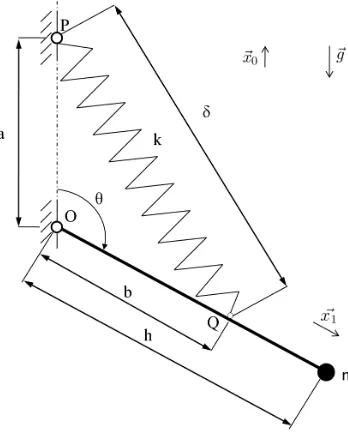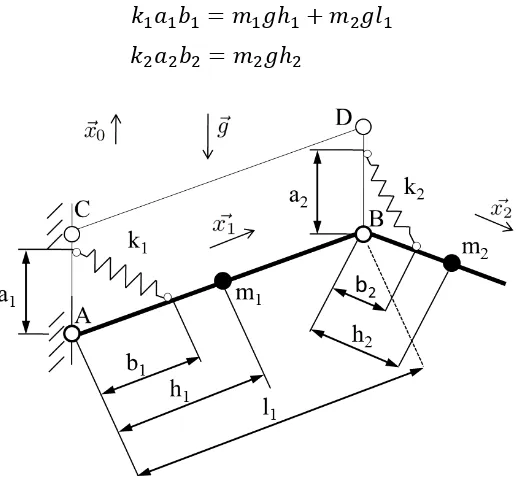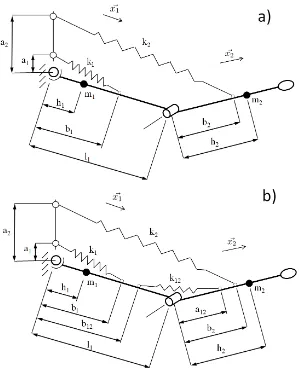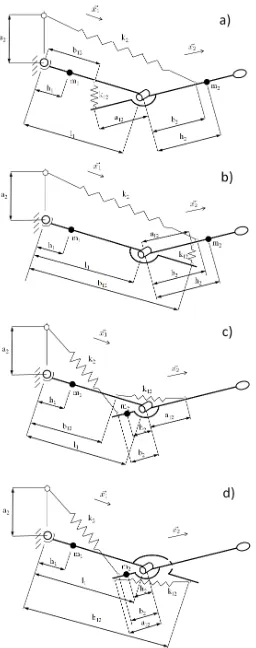Luigi Ascione, Valentino Berardi, Luciano Feo, Fernando Fraternali and Antonio Michele Tralli (eds.) Salerno, Italy, 4-7 September 2017
GRAVITY BALANCING OF A SPATIAL SERIAL 4-DOF ARM
WITHOUT AUXILIARY LINKS USING MINIMUM NUMBER OF
SPRINGS
Basilio Lenzo1 1
Sheffield Hallam University, Department of Engineering and Mathematics Howard Street, S1 1WB Sheffield (UK)
e-mail: [email protected]
Keywords: gravity balancing, serial kinematics, spatial kinematics, springs, anthropomorphic arm.
Abstract
The principle of gravity balancing has been studied for a long time. It allows a system to be in indifferent equilibrium regardless of the configuration. In the literature, gravity balancing has often been achieved using appropriate combinations of springs and auxiliary links. Some papers address potential layouts without auxiliary links, but limited to planar mechanisms.
This paper proposes a method to passively balance an anthropomorphic arm, with spatial kinematics, avoiding the use of auxiliary links.
The approach used in this paper includes the analysis of all the contributions to the potential energy of the arm. It is shown that they are proportional (according to geometrical and iner-tial parameters) to scalar products between configuration-dependent unit vectors and/or con-figuration-independent unit vectors.
1 INTRODUCTION
A machine is said to be gravity balanced if no actuator inputs are needed to keep the sys-tem in equilibrium, regardless of the configuration. From an Euler-Lagrange point of view the potential energy of the device is invariant, hence there is no force causing the system to change its configuration. The main motivation for studying gravity balancing is that it leads to significant decreases of the required actuator efforts during motion.
Excluding the trivial case in which the global centre of mass is inertially fixed, gravity bal-ancing can be achieved using counterweights [1, 2], with the drawback of adding inertia to the system, or using elastic elements [3, 4, 5], e.g. springs, to compensate the variations of poten-tial energy due to changes of configuration (motion of masses).
In the majority of literature, auxiliary links/parallelograms are needed when springs are used for gravity balancing [6, 7, 8], often making the mechanism bulky and/or reducing its workspace. A recursive method to achieve gravity balancing without auxiliary links is intro-duced in [9], but it is limited to planar mechanisms.
This paper proposes a simple method to balance a spatial mechanism using springs without auxiliary links. The case-study mechanism features an anthropomorphic (spatial) kinematics.
2 GRAVITY BALANCING PRINCIPLE
Consider a single link, pivoted at point , having mass and centre of mass located at distance ℎ from (Figure 1). The rotation angle allowed by the hinge in is the only de-gree of freedom (dof) of the system.
Figure 1: Single link system, 1 dof.
The gravitational potential energy of the system, , is
= ℎ ∙ = ℎ cos (1)
distance from point , being aligned with the unit vector , opposite to the gravity ac-celeration vector . Point is located at distance from point , being aligned with the unit vector defining the orientation of the link.
The elastic potential energy of the spring, , is
= = = ∙ (2)
where = + is a constant, hence it does not depend on the mechanism configura-tion . The total potential energy of the system, , is given by the sum of the gravitaconfigura-tional potential energy, , and the elastic potential energy, , as
= + = + ℎ − ∙ (6)
To let be constant independent of the mechanism configuration, needs to be independent of ∙ . This happens if the coefficient of ∙ is zero. As a result, the system is gravity balanced when the following relation is satisfied
= ℎ (7)
It is useful to study the extension of this approach to mechanisms with more degrees of freedom. Consider the 2 dof linkage depicted in Figure 2. A subscript ! is introduced in the notation, referring to the generic link ! quantities. For example, is the mass of link 2, and is the unit vector defining the orientation of link 2. Also, the quantity "# is introduced to denote the length of link !. This system can be balanced using two springs, as follows. The gravitational potential energy of the system, , , is
, = ℎ ∙ + " + ℎ ∙ =
ℎ + " ∙ + ℎ ∙ (8)
In (8) two configuration dependent contributions appear, i.e. ∙ and ∙ . A potential solution is to use two springs, the first to cancel the ∙ contribution, the second to cancel the ∙ contribution. A set of auxiliary links, i.e. a 4 bar mechanism ABCD, is added to the system as shown in Figure 2. As a result, one end of the spring is aligned with , thus generating the required ∙ contribution. The elastic potential energy of the system, , , results
, = − ∙ − + − ∙ − =
Similarly to (5), = 1 + + 2 + is a constant. Finally, considering the total potential energy of the system, = , + , , and equating each of the contributions in (8) and (9) as in (6), the system is gravity balanced when the following relations are satis-fied:
= ℎ + "
= ℎ (10)
Figure 2: Two links system, 2 dof.
This approach can be further extended to design a gravity balancing system for & dof serial spatial mechanisms as described in [3]. In particular, one spring would be required for each dof, together with appropriate auxiliary links.
3 PROBLEM ANALYSIS
3.1Case study mechanism
The spatial mechanism studied is a 4 dof anthropomorphic arm including: i) a spherical joint representing the glenohumeral joint, modelling the shoulder adduction-abduction dof, the shoulder flexion dof, and the shoulder rotation dof; ii) a rotational joint, modelling the el-bow flexion dof.
That is a 4 dof mechanism, in theory needing 4 springs and relative auxiliary links (as de-scribed above). However, because the first three degrees of freedom are obtained by means of a single spherical joint, only one spring is needed for the first link of the kinematic chain. So, only two springs can balance the whole robotic manipulator. Actually, the spherical joint does not make any difference with respect to a rotational joint [3].
Figure 3: 4 dof system considered: anthropomorphic arm.
3.2Balancing without auxiliary links and minimum number of springs
The gravitational potential energy of the system, ,', has the same form of the one shown in (8):
,' = ℎ ∙ + " + ℎ ∙ =
ℎ + " ∙ + ℎ ∙ (11)
The contribution ∙ can be balanced using a spring (with stiffness ) installed as the one with stiffness in Figure 2. Also a contribution ∙ has to be compensated with a spring, but this task is less trivial without the 4-bar mechanism shown in Figure 2. A first attempt is to attach a spring (with stiffness ) from the fixed frame directly to the second link. The re-sulting layout is shown in Figure 4a.
Geometrically, the spring with stiffness in Figure 4a is a side of a triangle, being the other two sides and " + . The latter is the vector from the first hinge of the mechanism to the attachment point of the spring on the link. The elastic potential energy of the system, ,'(, is
As expected there is a contribution ∙ , however also an undesired ∙ contribution ap-pears. ) is a constant.
The problem of the ∙ contribution is solved adding a third spring (with stiffness ) connected between the first and the second link, as shown in Figure 4b (where the quantities
and are defined). Following the same method, the elastic potential energy becomes
,'* = ' − ∙ − ∙ + " ∙ − " ∙ +
+ " − ∙ (13)
Figure 4: 4 dof system without auxiliary links: a) two springs, system not balanced; b) three springs
Hence, looking at the overall potential energy of the system, collecting all the terms +∙ ,
(! ≠ .) in (11) and (13), the system is gravity balanced when the following relations are satis-fied
ℎ + " − − " ∙ = 0
ℎ − ∙ = 0
" + " − ∙ = 0 (14)
In (14) the spring with stiffness introduces a contribution ∙ , as the spring with stiffness does. So, the spring with stiffness may be removed from the architecture of Figure 4b. This leads to a system with minimum number of springs (i.e. two). At last, to pas-sively balance the system against gravity, it must be
ℎ + " − " = 0
ℎ − = 0
If #, "#, ℎ# are given, the system (15) consists of three equations in six unknowns ( , , , , , ), allowing some design freedom. It should be considered that the lengths , , , , ℎ , ℎ can be negative. The physical meaning is that the denoted quan-tity has opposite direction with respect to the associated unit vector. For example, < 0
means that one attachment point of the spring with stiffness lays on the extension of link 2 behind the hinge connecting link 1 and link 2 (this is further clarified below as well as in Figure 5). In the remainder, ℎ > 0 is assumed.
Four potential layouts are developed, as shown in Figure 5: - layout a): < 0, < " , > 0;
- layout b): > 0, > " , > 0; - layout c): > 0, < " , < 0; - layout d): < 0, > " , < 0.
From the first equation in (15), > 0 is mandatory, meaning that the attachment point of the spring with stiffness must be above the first joint of the mechanism. This can be intui-tively explained looking at Figure 1: if point P was below point O, the link would be pulled downwards by the spring. The force applied from the spring in point Q would generate a clockwise moment with respect to point O, with the same sign of the moment contribution due to the weight of the link. Thus the system could not be gravity balanced.
According to the second equation in (15), layouts c) and d) work only if ℎ < 0, which is possible (e.g. it was chosen in [11]) but inconvenient for the kind of serial mechanism studied. Moreover, layouts c) and d) imply a potential intersection between the spring with stiffness and link 1. Additionally, layout d) entails an extension of both links, while only one link has to be extended for the other layouts. That makes layouts a) and b) preferable.
Finally, layout b) is chosen because the spring with stiffness in layout a), together with the extension of link 2 behind the elbow joint, may reduce the workspace of the arm. In par-ticular, the range of the spherical joint would be affected. On the other hand, the extension of link 1 in layout b) is less troublesome, also because of the limited range of the human elbow joint (the elbow cannot move backwards).
4 CONCLUSION
This paper proposed a gravity balancing method for an anthropomorphic arm, with spatial kinematics, using passive elements (springs) and avoiding the use of auxiliary links.
According to the method proposed, only two springs are needed to balance the mechanism. Still, there are more parameters than equations. Different layouts have been studied, highlight-ing their potential benefits and drawbacks. A final layout has been identified. Future work will present the implementation and experimental study of the selected configuration.
REFERENCES
[2] B. Lenzo, M. Fontana, S. Marcheschi, F. Salsedo, A. Frisoli, M. Bergamasco, Track-hold: A Novel Passive Arm-Support Device, ASME Journal of Mechanisms and Robot-ics, 8 (2), 021007-021007-9, 2016.
[3] B. Lenzo, A. Frisoli, F. Salsedo, M. Bergamasco, New gravity balancing technique and hybrid actuation for spatial serial manipulators, Advances in Robot Kinematics, Spring-er IntSpring-ernational Publishing, 419-427, 2014.
[4] P. Lin, W. Shieh, D. Chen, A theoretical study of weight-balanced mechanisms for de-sign of spring assistive mobile arm support (MAS), Mechanism and Machine Theo-ry,61, 156-167, 2013.
[5] B. Lenzo, A. Frisoli, F. Salsedo, M. Bergamasco, An innovative actuation concept for a new hybrid robotic system, Romansy 19–Robot Design, Dynamics and Control, Spring-er Vienna, 135-142, 2013.
[6] S. K. Agrawal, A. Fattah, Theory and design of an orthotic device for full or partial gravity-balancing of a human leg during motion, IEEE Transactions on Neural Systems and Rehabilitation Engineering, 12 (2), 157-165, 2004.
[7] T. Rahman, R. Rungun, S. Rahamim, H. William, A simple technique to passively grav-ity-balance articulated mechanisms, Transactions-American Society Of Mechanical En-gineers Journal Of Mechanical Design,117, 655-657, 1995.
[8] S. K. Agrawal, A. Fattah, Gravity-balancing of spatial robotic manipulators, Mechanism and machine theory, 39 (12), 1331-1344, 2004.
[9] S. R. Deepak, S. R., G. K. Ananthasuresh, Static balancing of spring-loaded planar rev-olute-joint linkages without auxiliary links, 14th National Conference on Machines and Mechanisms (NaCoMM09), Durgapur, India, December 18th, 2009.
[10] A. A. Delissen, G. Radaelli, J. L. Herder, Design and optimization of a general planar zero free length spring, Mechanism and Machine Theory, 117, 56-77, 2017.




